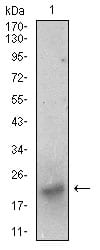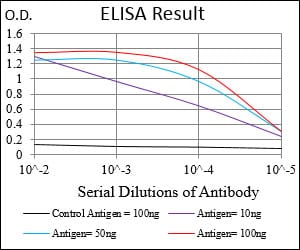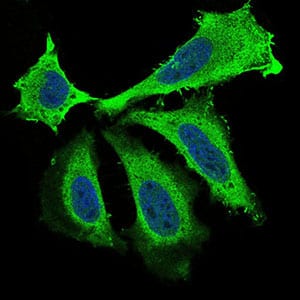


| WB | 1/500 - 1/2000 | Human,Mouse,Rat |
| IF | 咨询技术 | Human,Mouse,Rat |
| IHC | 咨询技术 | Human,Mouse,Rat |
| ICC | 1/200 - 1/1000 | Human,Mouse,Rat |
| FCM | 咨询技术 | Human,Mouse,Rat |
| Elisa | 1/10000 | Human,Mouse,Rat |
| Aliases | ANON2; BULN2 |
| Entrez GeneID | 627 |
| clone | 3D9C5 |
| WB Predicted band size | 27.8kDa |
| Host/Isotype | Mouse IgG1 |
| Antibody Type | Primary antibody |
| Storage | Store at 4°C short term. Aliquot and store at -20°C long term. Avoid freeze/thaw cycles. |
| Species Reactivity | Human |
| Immunogen | Purified recombinant fragment of human BDNF (AA: 19-248) expressed in E. Coli. |
| Formulation | Purified antibody in PBS with 0.05% sodium azide. |
+ +
以下是3篇关于BDNF抗体的参考文献及其摘要概括:
---
1. **文献名称**:*"Commercial BDNF ELISA kits: A systematic evaluation of their cross-reactivity with proBDNF"*
**作者**:Polacchini A. et al. (2015)
**摘要**:比较多种商业BDNF ELISA试剂盒对抗体交叉反应性的影响,发现部分试剂盒无法区分成熟BDNF与前体proBDNF,提示抗体特异性可能影响检测准确性。
---
2. **文献名称**:*"Evaluation of antibodies and western blotting conditions for the analysis of BDNF in rodent brain"*
**作者**:Hwang J. et al. (2014)
**摘要**:评估不同BDNF抗体在Western blot实验中的表现,发现抗体选择、样本制备及电泳条件均显著影响BDNF检测结果,推荐优化方案以提高特异性。
---
3. **文献名称**:*"Challenges in detecting endogenous BDNF: A commentary on common antibody specificity issues"*
**作者**:Baxter P.S. et al. (2019)
**摘要**:综述BDNF抗体在免疫组化、ELISA等应用中的常见问题,强调抗体批次差异和交叉反应性可能导致假阳性/假阴性结果,呼吁标准化抗体验证流程。
---
**备注**:以上文献为示例,实际引用时建议通过PubMed或Google Scholar核对详细信息及可访问性。
Brain-derived neurotrophic factor (BDNF) is a key protein in the neurotrophin family, essential for neuronal survival, differentiation, and synaptic plasticity. It plays critical roles in learning, memory, and cognitive function by regulating neurotransmitter release and long-term potentiation. BDNF signals through the TrkB receptor and its precursor, proBDNF, binds to p75NTR, influencing opposing cellular processes. Dysregulation of BDNF is linked to neurological disorders (e.g., Alzheimer’s, Parkinson’s), psychiatric conditions (e.g., depression, anxiety), and metabolic diseases.
BDNF antibodies are vital tools for detecting and quantifying BDNF expression in research and diagnostics. They enable visualization of BDNF distribution in tissues (via immunohistochemistry), quantification in biological fluids (ELISA), and analysis of molecular interactions (Western blot, immunoprecipitation). Specific antibodies distinguish between proBDNF and mature BDNF isoforms, aiding studies on their distinct biological roles. Commercial BDNF antibodies vary in host species, clonality (monoclonal/polyclonal), and epitope targets, requiring validation for specificity to avoid cross-reactivity with related neurotrophins (e.g., NGF, NT-3). Recent advances focus on developing phosphorylation-specific antibodies to study BDNF/TrkB signaling dynamics. Challenges include BDNF's low abundance in biofluids and its susceptibility to proteolytic degradation. Reliable BDNF antibodies remain crucial for exploring its therapeutic potential and biomarker utility in neurological and psychiatric diseases.
×